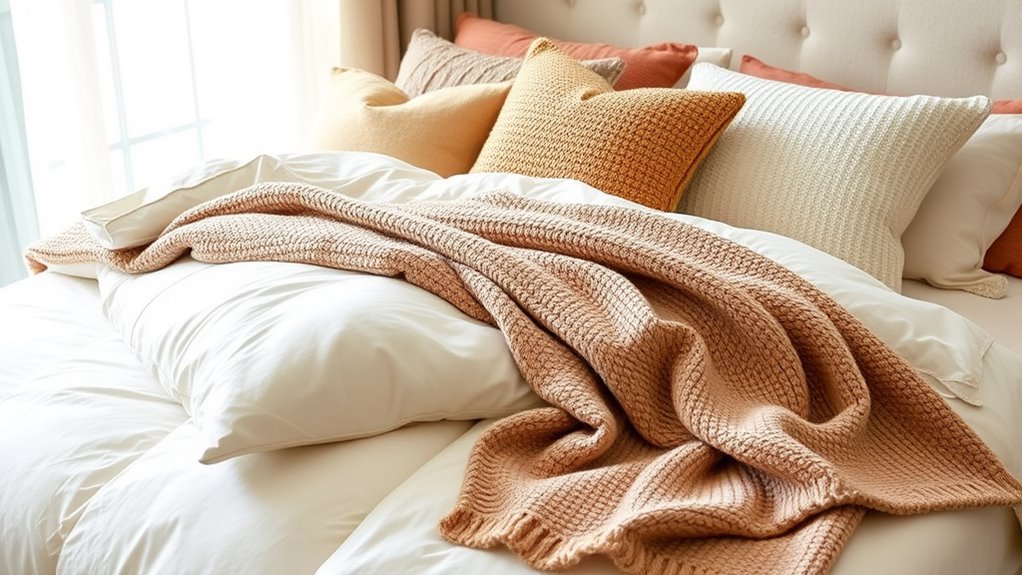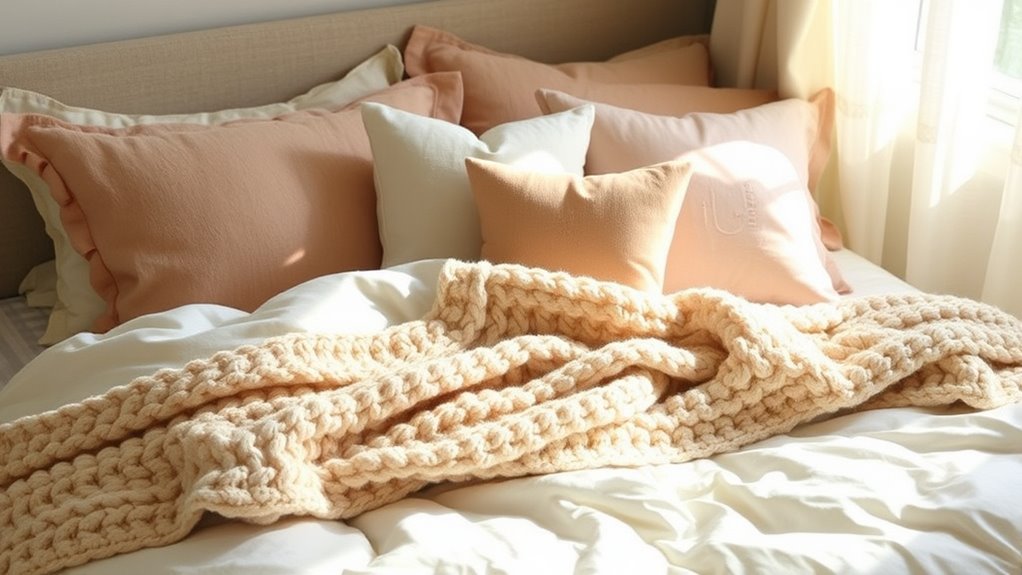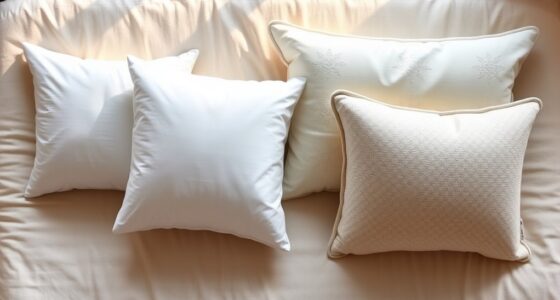To layer your bedding for seasonal comfort, start with breathable sheets made of cotton or linen for summer, and switch to flannel or flannel-blend sheets as it gets colder. Add or remove duvet inserts based on the season—lighter for warmer months, heavier for winter. Incorporate decorative throws and protectors to enhance warmth or airflow. Adjust these layers as needed; if you want to master the perfect setup, there’s more to discover below.
Key Takeaways
- Use lightweight, breathable fabrics like cotton or linen in summer for coolness and airflow.
- Swap heavy duvet inserts for lighter versions or remove them during warmer months.
- Incorporate decorative throws or blankets that can be added or removed based on temperature.
- Layer bedding components (sheets, duvet, cover) to easily adjust warmth levels as seasons change.
- Add or remove mattress and pillow protectors to enhance insulation or cooling as needed.

As the seasons change, adjusting your bedding guarantees you stay comfortable all year round. To achieve this, understanding different duvet types is essential. Duvets come in various fillings, such as down, wool, synthetic, and cotton. Down duvets, known for their warmth and lightweight feel, are perfect for winter, while lighter alternatives like cotton or synthetic duvets work well during warmer months. By swapping out your duvet types seasonally, you can maintain the ideal balance between warmth and breathability.
Layering is all about versatility, and decorative throws play a significant role in this process. Not only do they add a splash of color or texture to your bed, but they also provide extra warmth when needed. During colder months, draping a chunky knit or plush throw over your duvet instantly boosts the coziness factor. For summer, a lightweight decorative throw can be neatly folded at the foot of your bed, adding style without bulk. These throws are easy to switch out, making it simple to adapt your bedding aesthetic and comfort level throughout the year.
In addition to choosing the right duvet types and incorporating decorative throws, consider the sheets and pillowcases you use. Opt for breathable fabrics like cotton or linen in the summer to prevent overheating, and switch to flannel or flannel-blend sheets as temperatures drop. Layering with a fitted sheet, a duvet, and a duvet cover creates a modular setup that’s easy to adjust. If you’re using a duvet insert that is too heavy during warmer months, simply replace it with a lighter one, or remove it altogether to use just a sheet and a decorative throw for a minimalist approach.
You should also pay attention to the bedding accessories, such as mattress protectors and pillow protectors, which can add an extra layer of insulation or cooling. When shifting between seasons, laundering and swapping these out helps maintain freshness and comfort. Additionally, choosing bedding with high-quality materials can improve temperature regulation and overall comfort. Remember, the key is flexibility. Using different duvet types and decorative throws allows you to tailor your bed to the changing weather without overhauling your entire bedding setup. With a little planning and the right accessories, you’ll stay cozy in winter and cool in summer, all while keeping your bedroom stylish and inviting.
Frequently Asked Questions
What Are the Best Materials for Breathable Seasonal Bedding?
When choosing breathable seasonal bedding, you should look for natural fibers like cotton, linen, and bamboo, which allow air to flow and keep you cool. Moisture-wicking fabrics are also great because they draw sweat away from your skin, helping you stay dry and comfortable. Combining these materials guarantees your bedding adapts to changing temperatures, providing a restful sleep no matter the season.
How Do I Prevent Allergies With Layered Bedding?
Think of your bedding as a fortress guarding you from allergy triggers. To prevent allergies, choose hypoallergenic fabrics that keep dust mites at bay and opt for allergy-proof covers on pillows and mattresses. Wash your bedding regularly in hot water to flush out allergens. By creating this barrier, you protect your sleep sanctuary, ensuring peaceful, allergy-free nights all year round.
Can Layering Bedding Help Reduce Energy Costs?
Layering your bedding can definitely help with energy conservation and cost savings. By adding or removing layers based on the season, you can stay comfortable without cranking up the thermostat or heater. During colder months, thicker layers trap heat and reduce your reliance on heating, lowering energy costs. In warmer seasons, lighter layers keep you cool. This flexible approach allows you to save energy and cut costs year-round.
How Often Should I Change My Bedding Layers Seasonally?
Switching sheets and swapping sleepsets seasonally keeps your bedding fresh and fabulous. You should alter your bedding layers at least once every three months or more often if you notice dirt or sweat. Incorporate seasonal laundry routines to cleanse and refresh, and mattress protection strategies to prolong bedding lifespan. Staying consistent with these changes ensures comfort, cleanliness, and cozy nights, no matter the season.
Are There Specific Color Schemes That Suit Different Seasons?
You might wonder if certain color schemes suit different seasons. Choosing a seasonal color palette can boost your space’s vibe, so opt for warm, earthy tones in fall and winter, like deep reds and browns. For spring and summer, go for fresh, light hues such as pastels and bright whites. Incorporate seasonal accents like floral patterns or textured throws to enhance your bedding and reflect the changing seasons beautifully.
Conclusion
Think of your bedding like a cozy garden: in spring, you add delicate blooms; in summer, lush greenery; in fall, warm leaves; and in winter, a soft blanket of snow. By layering thoughtfully, you create a sanctuary that adapts effortlessly with the seasons. Just as a garden thrives with the right mix of elements, your bed becomes a haven of comfort, perfectly attuned to each change in weather. Embrace these layers, and sleep will always feel like a peaceful season.









